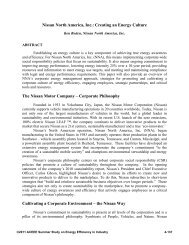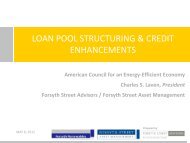Energy and Water Performance Benchmarking in the Retail Sector ...
Energy and Water Performance Benchmarking in the Retail Sector ...
Energy and Water Performance Benchmarking in the Retail Sector ...
You also want an ePaper? Increase the reach of your titles
YUMPU automatically turns print PDFs into web optimized ePapers that Google loves.
The correlation between predicted <strong>and</strong> actual greenhouse emissions is shown below <strong>in</strong><br />
Figure 6:<br />
Figure 6: Predicted vs. Actual Shopp<strong>in</strong>g Centre GHG Emissions<br />
When applied to <strong>the</strong> total data set expressed <strong>in</strong> total kgCO2, <strong>the</strong> regression equation has<br />
an R² of 0.56, <strong>in</strong>dicat<strong>in</strong>g that <strong>the</strong> factors represented <strong>in</strong> <strong>the</strong> regression equation account for 56%<br />
of <strong>the</strong> variability <strong>in</strong> <strong>the</strong> data set. Note that <strong>the</strong> l<strong>in</strong>e with<strong>in</strong> this graph is a 1:1 relationship, <strong>and</strong> not<br />
a trend-l<strong>in</strong>e.<br />
In order to evaluate <strong>the</strong> efficiency of <strong>the</strong> shopp<strong>in</strong>g centre aga<strong>in</strong>st this metric, <strong>the</strong> actual<br />
consumption of <strong>the</strong> centre should be compared aga<strong>in</strong>st <strong>the</strong> predicted emissions for an “average”<br />
centre with <strong>the</strong> same characteristics. Measured consumption that is lower than predicted<br />
consumption <strong>in</strong>dicates better than average shopp<strong>in</strong>g centre greenhouse emissions.<br />
<strong>Water</strong> <strong>Benchmark<strong>in</strong>g</strong><br />
A similar process was used to develop water benchmarks, with <strong>the</strong> key difference that<br />
water consumption <strong>in</strong>cludes water consumption of tenants, as most sites have a s<strong>in</strong>gle ma<strong>in</strong><br />
water meter. The water model has a substantially better fit to <strong>the</strong> underly<strong>in</strong>g data than <strong>the</strong> energy<br />
model, with <strong>the</strong> water model expla<strong>in</strong><strong>in</strong>g 89% of <strong>the</strong> variation <strong>in</strong> water consumption.<br />
Key parameters with<strong>in</strong> <strong>the</strong> water consumption model are:<br />
• The Gross Lettable Area <strong>Retail</strong>, <strong>in</strong> square metres, AGLAR<br />
• The quantity of cool<strong>in</strong>g degree days <strong>in</strong> <strong>the</strong> year, base 15°C wet bulb, CDD15wb<br />
• The area of gymnasium tenants, <strong>in</strong> square metres, Agym<br />
• The number of food court seats provided, nfcs<br />
• And <strong>the</strong> number of c<strong>in</strong>ema <strong>the</strong>atrettes, n<strong>the</strong>atrettes<br />
©2010 ACEEE Summer Study on <strong>Energy</strong> Efficiency <strong>in</strong> Build<strong>in</strong>gs<br />
3-12




